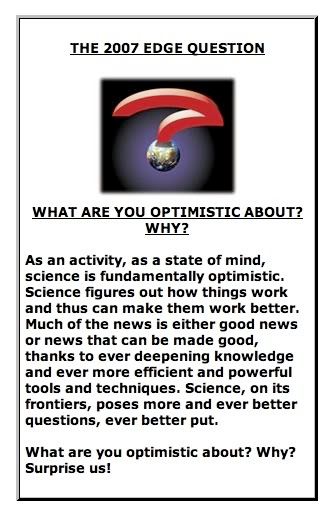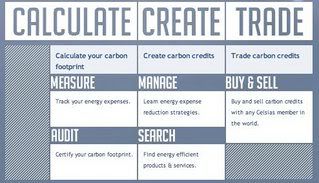In the February issue of the Harvard Business Review, I came across
The HBR List of Breakthrough Ideas for 2007.

This is the result of an annual survey of
--
“emerging ideas that consider how nanotechnology will affect commerce,
-- what role hope plays in leadership,
-- and why - in an age that practically enshrines accountability - we need to beware of “accountabalism.” The following is an excerpt of the highlights. I highly recommend that you take the time to read the
full article. It is insightful and, at times, witty.
1. The Accidental Influentials by Duncan J. Watts In his best seller The Tipping Point, Malcolm Gladwell argues that “social epidemics” are driven in large part by the actions of a tiny minority of special individuals. The idea seems intuitively right—we think we see it happening all the time. Nevertheless, this isn’t actually how ideas spread. It’s better to focus on getting enough plain, ordinary people to sign on.
2. Entrepreneurial Japan by Yoshito Hori Japan’s economic rebound is generally attributed to the turnaround of corporate giants and to industry consolidation. But it is also fueled by the emergence of new companies led by entrepreneurs in their twenties and thirties. An entrepreneurial Japan—no longer an oxymoron—may ultimately overshadow the much touted start-up cultures of China and India.
3. Brand Magic: Harry Potter Marketing by Frédéric Dalsace, Coralie Damay, and David Dubois Most brands target a specific age group. The big problem with this approach is that it positively discourages customer loyalty— and, as we all know, it’s a lot cheaper to keep customers than to find new ones. To get around this problem, companies should consider creating brands that mature with their customers.
4. Algorithms in the Attic by Michael Schrage For a powerful perspective on future business, take a hard look at mathematics past: the old equations collecting dust on academics’ shelves. Just as big firms need the keen eye of an intellectual property curator to appreciate the value of old patents and know-how, they will need savvy mathematicians to resurrect long-forgotten equations that, because of advancing technology, can finally be applied to business.
5. The Leader from Hope by Harry Hutson and Barbara Perry Most business leaders shy away from the word “hope.” Yet hope has been shown to be the key ingredient of resilience in survivors of traumas ranging from prison camps to natural disasters. So if you are an executive trying to lead an organization through change, know that hope can be a potent force in your favor. And it’s yours to give.
6. An Emerging Hotbed of User-Centered Innovation * by Eric von Hippel Most countries, developing and developed alike, view innovation as a vital input to their economic growth and spend varying portions of their national budgets to support it in companies and research labs, for the ultimate benefit of essentially passive consumers. Denmark is taking a different tack: It’s making “user-centered innovation” a national priority.
7. Living with Continuous Partial Attention by Linda Stone “Continuous partial attention”—distinct from multitasking—is an adaptive behavior that presumably allows us to keep pace with the never-ending bandwidth technology offers. Now there are signs of a backlash against the tyranny of tantalizing choices.
8. Borrowing from the PE Playbook by Michael C. Mankins Company coffers are overflowing these days, and inevitably executives are turning to the M&A markets in their quest to put the cash to good use. If they’re to avoid repeating the disappointments of previous M&A waves, they will have to take a few leaves from the acquisition playbook of private equity firms.
9. When to Sleep on It by Ap Dijksterhuis Use your conscious mind to acquire all the information you need to arrive at a difficult decision, but don’t try to analyze it. Instead, go on holiday and let your unconscious mind digest the information for a day or two. Whatever your intuition then tells you is almost certainly going to be the best choice.
10. Here Comes XBRL by Robert G. Eccles, Liv Watson, and Mike Willis A new software standard for financial and business reporting, soon to be adopted by the U.S. Securities and Exchange Commission, will make it dramatically easier to generate, validate, aggregate, and analyze business and financial information—which in turn will improve the quality of the information companies use to make decisions.
11. Innovation and Growth: Size Matters by Geoffrey B. West Newfound general mathematical relationships between population size, innovation, and wealth creation challenge the conventional wisdom that smaller innovation functions are more inventive. They may explain why few organizations today have matched the creativity of a giant like Bell Labs in its heyday.
12. Conflicted Consumers by Karen Fraser Your customer data indicate strong consumer satisfaction: Repeat purchase levels are high, and many customers have been with you for years. Good news, right? Well, appearances can be deceptive. Buried in the data may be a “stealth” segment of apparently loyal customers whose ethical concerns make them ready to bolt as soon as an alternative emerges.
13. What Sells When Father Knows Best by Phillip Longman The link between conservatism and fertility is found throughout the world, and it portends a comeback for patriarchy and other traditional values. Business leaders must learn how to profit from, or at least prepare for, this trend.
14. Business in the Nanocosm by Rashi Glazer Though the scientific and technological revolution that may occur as a result of nanotechnology has been much discussed, the sociocultural and business implications are of potentially much greater impact. Nanotechnology may change society over the next few decades just as much as information technology has over the previous few—and in ways that are still hard to grasp.
15. Act Globally, Think Locally by Yoko Ishikura Companies are usually told to “think globally and act locally.” But thanks to their own global information systems and the Internet, knowledge from faraway places can be acquired relatively easily and cheaply. This means that firms have to discover and quickly incorporate good ideas from these diverse sources before their rivals do.
16. Seeing Is Treating by Klaus Kleinfeld and Erich Reinhardt When several technologies can be leveraged simultaneously, the possibilities for real breakthroughs in medical care multiply. That is occurring today with the convergence of imaging technology and biotechnology, which promises to radically change the diagnosis and treatment of many chronic diseases, greatly benefiting both patients and the companies that serve them.
17. The Best Networks Are Really Worknets by Christopher Meyer The assumption is that if you build a network platform, people will come. If you expect to get real value from your initiative, though, you must think hard and in advance about exactly what function you want the network to perform. That will help you choose the participants, the nature of their experiences, and the technology. In other words, put the work in “network” first.
18. Why U.S. Health Care Costs Aren’t Too High by Charles R. Morris Contrary to popular belief, health care costs, broadly defined, are quite probably falling. It is spending that is rising, which is not the same thing at all. The benefits of health care for individuals, society, and the economy—such as getting people back to work faster—more than outweigh its direct costs.
19. In Defense of “Ready, Fire, Aim" by Clay Shirky The bulk of open source projects fail, and most of the remaining successes are quite modest. Still, open systems are a profound threat to many businesses, not only because they outsucceed commercial firms but, more important, because they outfail them.
20. The Folly of Accountabalism by David Weinberger Accountability has gone horribly wrong. It has become “accountabalism,” a set of related beliefs and practices that bureaucratize morality and make us believe we can control our lives by adhering to specific rules. But grown-ups prefer clarity and realism to happy superstition.














